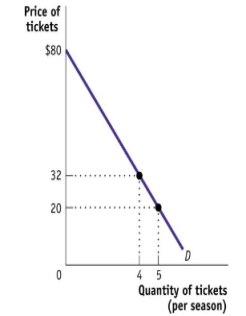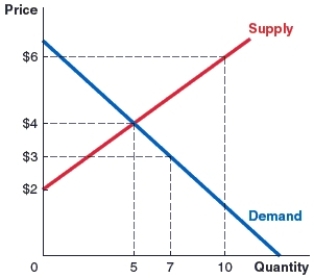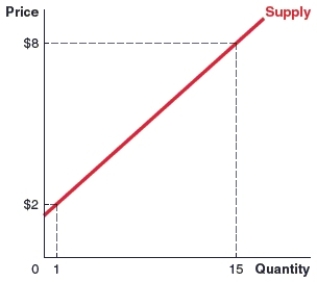A) each unit of output will go to the person who will get the highest marginal benefit from it.
B) each unit of output will be produced at minimum fixed cost.
C) output will be distributed evenly across consumers and producers.
D) consumers will each pay a price equal to the marginal benefit received from the good.
Correct Answer

verified
Correct Answer
verified
Multiple Choice
The most efficient outcome in a set of options is the one with the:
A) largest economic surplus.
B) lowest total costs.
C) lowest total benefit.
D) smallest positive difference between benefits minus total cost.
Correct Answer

verified
Correct Answer
verified
Multiple Choice
An efficient producer will keep increasing production until:
A) total benefit equals total cost.
B) minimum average cost has been reached.
C) maximum benefit equals maximum cost.
D) price equals marginal cost.
Correct Answer

verified
Correct Answer
verified
Multiple Choice
Which of the following is a positive economic statement?
A) The government ought to balance its budget and eliminate the deficit.
B) That company with a 50% profit rate made too much profit at the expense of consumers.
C) If the government raises taxes, people will have less income available for purchases and saving.
D) A 10% inflation rate is too high and should be reduced.
Correct Answer

verified
Correct Answer
verified
Multiple Choice
What is positive analysis?
A) It prescribes what should happen, which involves value judgments.
B) It puts the options that are available in order of the priorities held by the decision maker.
C) It is based on beliefs about what is most important.
D) It describes what is happening, explains why it is happening, or predicts what will happen.
Correct Answer

verified
Correct Answer
verified
Essay
(Figure: Demand for Chicago Cubs Tickets) The figure Demand for Chicago Cubs Tickets represents Jeremy's annual demand for tickets to Chicago Cubs baseball games. At $20, Jeremy will purchase five tickets. How much consumer surplus does Jeremy receive?

Correct Answer

verified
Correct Answer
verified
Multiple Choice
(Figure: Market 3) Use the graph for the watermelon market to answer the question.
What is the economically efficient quantity of watermelons?

A) two
B) five
C) seven
D) 10.5
Correct Answer

verified
Correct Answer
verified
Multiple Choice
The economic surplus in a market is the:
A) excess demand due to a price below the equilibrium price.
B) surplus that accrues when a good is not scarce, defined as the total amount (if any) by which quantity demanded exceeds quantity supplied at a zero price.
C) marginal benefit less the marginal cost of a good.
D) sum of consumer surplus and producer surplus.
Correct Answer

verified
Correct Answer
verified
Multiple Choice
Markets distribute production across companies in a way that:
A) maximizes the number of firms.
B) minimizes production.
C) minimizes costs.
D) maximizes production.
Correct Answer

verified
Correct Answer
verified
Multiple Choice
The rational rule for markets is to produce:
A) the output level with minimum average cost and buy the quantity with maximum benefit.
B) more if the unit's marginal benefit exceeds its marginal cost.
C) at the output where efficient quantity equals benefit.
D) less if marginal benefit exceeds marginal cost.
Correct Answer

verified
Correct Answer
verified
Multiple Choice
A market's deadweight loss is calculated as:
A) the economic loss that a firm has when it is not producing its profit-maximizing output.
B) the loss to consumers when a product malfunctions or fails to meet expectations.
C) the economic surplus at the efficient quantity minus the economic surplus at the actual quantity.
D) the price at equilibrium minus the price at actual quantity.
Correct Answer

verified
Correct Answer
verified
Multiple Choice
When goods are allocated in a way that creates the largest economic surplus:
A) output is evenly allocated across firms.
B) production is minimized.
C) efficient allocation has been achieved.
D) the marginal benefit of the last unit bought is the maximum marginal benefit.
Correct Answer

verified
Correct Answer
verified
Essay
Measurement of economic efficiency provides important information about the functioning of a market. Why should this information be used cautiously?
Correct Answer

verified
Correct Answer
verified
Multiple Choice
A key difference between equity and efficiency is that equity deals with _____ and efficiency focuses on _____.
A) equality; minimizing costs
B) minimizing costs; equality
C) maximizing welfare; fairness
D) fairness; maximizing economic surplus
Correct Answer

verified
Correct Answer
verified
Multiple Choice
(Figure: Supply Curve 2) Use the supply curve for bottles of dish soap in the graph to answer the question.
If 15 bottles are sold at a price of $8, what is the total producer surplus?

A) $0
B) $6
C) $45
D) $90
Correct Answer

verified
Correct Answer
verified
Essay
Why are both positive analysis and normative analysis needed for decision making?
Correct Answer

verified
Correct Answer
verified
Multiple Choice
_____ determines the amount of economic surplus; ______ determines whether buyers or sellers get the surplus.
A) Price; quantity
B) Quantity; price
C) Marginal benefit; marginal cost
D) Marginal cost; marginal benefit
Correct Answer

verified
Correct Answer
verified
Multiple Choice
In a market graph, consumer surplus is the area:
A) between the demand curve and the supply curve.
B) above the price.
C) below the demand curve.
D) above the price and below the demand curve.
Correct Answer

verified
Correct Answer
verified
Multiple Choice
Markets achieve an efficient allocation of resources when:
A) the government intervenes in the market.
B) the quantity demanded equals the quantity supplied.
C) property rights are assigned.
D) the producer surplus is zero.
Correct Answer

verified
Correct Answer
verified
Multiple Choice
When government policies lead to outcomes that are worse than those that would occur in unregulated markets:
A) marginal costs occur.
B) liveweight loss occurs.
C) government failure occurs.
D) government efficiency occurs.
Correct Answer

verified
Correct Answer
verified
Showing 61 - 80 of 208
Related Exams